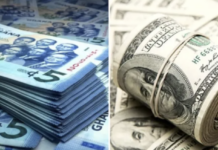
Moody’s Investors Service, a UK-based rating agency, has rated the Ghanaian Economy B3 – signalling stability from negative outlook.
The key drivers of the current rating, the agency said are being driven by “Significant fiscal deficit reduction and institutional reform implementation over the past year under the umbrella of the 3-year IMF programme starting April 2015;
“Reduced government liquidity risk on the external side after the successful issuance of a $750 million Eurobond in September earmarked to redeem the remaining $400 million October 2017 Eurobond maturity;
“Improved balance of payments dynamics amid continued development of oil and gas resources via higher foreign direct investment (FDI) inflows, supporting reserve buffers and reduced currency volatility.”
The stable outlook on the B3 rating, Moody added “balances these improvements against Ghana’s continuing credit challenges and vulnerabilities, including a high debt burden, very low debt affordability, elevated funding requirements and challenging medium-term international bond maturity profile.”
Postulating the rationale behind the favorable rating, the UK-based agency said the first driver for the assignment of a “stable outlook is the significant reduction in the fiscal deficit achieved under the umbrella of the 3-year Extended Credit Facility (ECF) programme since inception in April 2015, with a deficit reduction to 6.3% of GDP in 2015 from 10.2% in 2014.
“The improvement was underpinned by both improved revenue collection and expenditure control, in particular with respect to wages and salaries, and included the repayment of arrears in the amount of 2.4% of GDP.”
RATINGS RATIONALE
The key drivers of the rating action are:
(1) Significant fiscal deficit reduction and institutional reform implementation over the past year under the umbrella of the 3-year IMF programme starting April 2015;
(2) Reduced government liquidity risk on the external side after the successful issuance of a $750 million Eurobond in September earmarked to redeem the remaining $400 million October 2017 Eurobond maturity;
(3) Improved balance of payments dynamics amid continued development of oil and gas resources via higher foreign direct investment (FDI) inflows, supporting reserve buffers and reduced currency volatility.
The stable outlook on the B3 rating balances these improvements against Ghana’s continuing credit challenges and vulnerabilities, including a high debt burden, very low debt affordability, elevated funding requirements and challenging medium-term international bond maturity profile.
Ghana’s foreign- and local-currency bond ceilings remain unchanged, namely the foreign-currency bond ceiling at B1, the foreign-currency deposit ceiling at Caa1, and the local-currency bond and deposit ceilings at Ba3.
RATIONALE FOR ASSIGNING A STABLE OUTLOOK
The first driver for the assignment of a stable outlook is the significant reduction in the fiscal deficit achieved under the umbrella of the 3-year Extended Credit Facility (ECF) programme since inception in April 2015, with a deficit reduction to 6.3% of GDP in 2015 from 10.2% in 2014. The improvement was underpinned by both improved revenue collection and expenditure control, in particular with respect to wages and salaries, and included the repayment of arrears in the amount of 2.4% of GDP.
Budget execution data over the first five months of 2016 point to a tax and oil-related revenue shortfall exacerbated by temporary production interruptions at the Jubilee oil field, but which was mostly offset by capital expenditure cuts with no salary or goods expenditures overruns. The government has affirmed avoidance of recourse to central bank funding this year, in line with ECF conditionality, while parliament lowered the legal borrowing limit to 5% of previous year’s revenues from 10%. Moody’s anticipates a budget deficit of 6.1% of GDP this year, declining further to 5.3% in 2017.
Additional legislation recently adopted includes the Banks and Specialized Deposit-Taking Institutions Bill, the Deposit Insurance Bill, and the Public Finance Management Law aimed at improving spending control across all levels of government and including state-owned enterprises. The government has also devised a strategy to address outstanding legacy debts in the power utility sector, funded by energy levies introduced in January 2016. These legacy debts owed by state-owned utilities do not represent direct or explicitly guaranteed debt of the government.
These initiatives underscore the government’s commitment to the IMF programme, with reduced likelihood of renewed election-related expenditure overruns this year or in case of a change in administration after presidential and parliamentary elections scheduled for December 7, 2016.
The second driver of the assignment of a stable outlook is the improved government liquidity risk profile after the recent issuance of the $750 million 6-year Eurobond at 9.25% earmarked for the redemption of the remaining $400 million outstanding of the 8.5% October 2017 maturity. After that, the next international bond principal payment of $250 million is scheduled for 2020, indicating lower near-term external liquidity pressures.
That said, gross borrowing requirements remain elevated in 2017 at about 18% of GDP amid tight domestic and external funding conditions.
The government’s strategy to extend the maturity profile of outstanding domestic securities from currently about one year in order to reduce rollover risks in this segment benefits from the increased participation of nonresident investors observed over the first five months of this year, supported by the relative stability of the domestic currency against the US dollar over the past year.
Moody’s expects gradually lower inflation readings to allow for a reduction in domestic borrowing costs over the forecast horizon, thereby improving debt affordability measures such as interest/revenue currently at almost 30% as of May 2016.
The third driver for a stable outlook stems from improved balance of payments dynamics recorded in the first half of 2016. Moody’s expects the $750 million Eurobond proceeds in addition to the Cocobod loan in the amount of $1.8 billion to provide an increased foreign exchange buffer to better withstand external shocks such as renewed deterioration in the terms of trade or increased international capital market volatility following the anticipated tightening of US monetary policy.
Moody’s expects that Ghana’s fiscal and external accounts will also benefit from FDI inflows and the ramp-up in oil exports from the Tweneboa-Enyenra-Ntomme (TEN) oil field starting August 2016 towards 80,000 bpd at full capacity, and from the new Sankofa field with 30,000bpd starting production in the second quarter of 2017 before first gas expected in the second quarter of 2018. The development of this field benefits from a $700 million project guarantee from the World Bank.
RATIONALE FOR AFFIRMING THE RATING AT B3
The improvements in Ghana’s credit profile witnessed in recent quarters balances against the sovereign’s continuing credit challenges. Ghana’s fiscal strength remains among the weakest in Moody’s rated universe, with a high debt burden at 71.6% of GDP in 2015 and very low debt affordability as measured by interest/revenues at almost 30% as of May 2016.
Gross funding requirements remain high next year amid tight domestic and external funding conditions and in view of a significant international bond maturity schedule starting 2020. Moreover, an adverse ruling in 2017 by the International Tribunal of the Law of the Sea (ITLOS) on the border dispute with Cote d’Ivoire about ownership of the TEN oil field remains a tail risk, which could cost the government fiscal revenues of 0.5-1.0% of GDP annually at current oil prices in a worst case scenario.
That said, Ghana’s growth outlook benefits from halving of the power deficit through the installation of emergency power measures, and from oil and gas resource developments, the latter of which will significantly reduce the need for fuel imports to power domestic thermal plants. The track record of fiscal consolidation over the past two years has also supported the assessment of Ghana’s Institutional strength.
WHAT COULD CHANGE THE RATINGS UP/DOWN
Continued fiscal consolidation beyond the election horizon and implementation of the structural reform programme agreed with the IMF, including with regard to the restoration of financial viability in the state-owned power utility sector, would be credit positive.
Moody’s would consider a negative outlook in case of unanticipated and significant expenditure overruns which would halt or reverse the fiscal and external consolidation progress achieved thus far, undermine access to funding sources and jeopardize the continuity of the IMF programme. An adverse ruling in 2017 by ITLOS on the border dispute with Cote d’Ivoire would also be credit negative.
GDP per capita (PPP basis, US$): 4,266 (2015 Actual) (also known as Per Capita Income)
Real GDP growth (% change): 3.9% (2015 Actual) (also known as GDP Growth)
Inflation Rate (CPI, % change Dec/Dec): 17.7% (2015 Actual)
Gen. Gov. Financial Balance/GDP: -6.3% (2015 Actual) (also known as Fiscal Balance)
Current Account Balance/GDP: -7.6% (2015 Actual) (also known as External Balance)
External debt/GDP: 52.8% (2015 Estimate)
Level of economic development: Low level of economic resilience
Default history: No default events (on bonds or loans) have been recorded since 1983.
On 20 September 2016, a rating committee was called to discuss the rating of the Government of Ghana. The main points raised during the discussion were: The issuer’s economic fundamentals, including its economic strength, have not materially changed. The issuer’s institutional strength has improved. The issuer’s fiscal or financial strength, including its debt profile, has not materially changed. The issuer has become less susceptible to event risks.
By Mohammed Awal


























